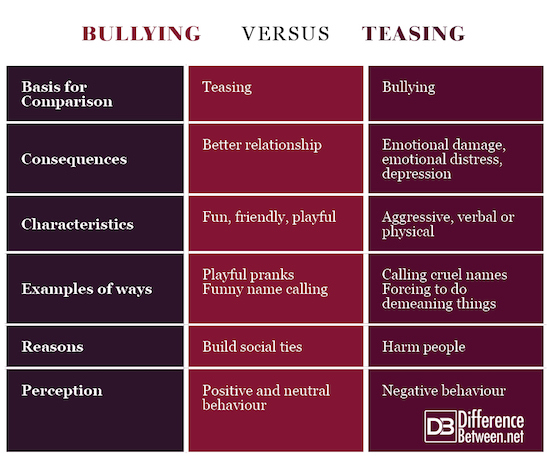Difference Between Teasing and Bullying
• Categorized under Language,Words | Difference Between Teasing and Bullying
One of the most common topics discussed in schools is bullying and teasing. Kids and young adults often poke and make fun of each other in a friendly way. Sometimes this goes too far when one party intentionally acts aggressively to hurt the other person either physically or emotionally. There is a thin line that separates teasing and bullying, however the key difference between them is solely based on intent.
What is Teasing?
Teasing is a fun, playful and friendly way of making fun of your peers, without their feelings. Kids enjoy poking and joking about each other, they however often fail to avoid the thin line that divides them. Teasing is a normal way of life. It is a social exchange that is considered friendly, negative or neutral. There are several ways of teasing; verbally and taunting.
Verbal teasing is fun when the people involved are giggling, laughing or smiling about it. It becomes hurtful when the individuals are making fun of each other using hurtful words. Teasing is also considered a way of relating with each other to form connections and make the relationships closer. The other pros of teasing are the ability of dealing with awkward situations and promotion of the social affiliations. This simple practice can turn hostile when either of the party involved uses it as a means of gaining social status, exercise their authority on a weaker victim or to hurt a person. If this practice continues for a while, the label changes to bullying.
What is Bullying?
Bullying is often characterized with an imbalance of power where the privileged opponent exerts their power mentally and physically to the weaker individual. Bullying is often thought of as physical harm, it however is mostly verbal. Verbal bullying can take form in many ways; slurs, hostile teasing or name calling regarding race, religion, sexual orientation or general abuses.
There are three components that can be used to define bullying; intentional, a power grab and repeated (as it has the potential of being repeated in time). Intentional here refers to the act being purposefully aggressive and hurtful. Students are usually not ready to admit to being mean on purpose, it is important for grownups to assess the situation and keenly review patterns before making a judgement. If the culprit bullies another individual once, it could be unintentional. However, if the behavior is repeated the culprit can now be classified as a bully. Power grab refers to the act where an individual tries to dominate another or belittle them forcefully. This power grab behavior can be placed into four categories:
- Physical Bullying. This is an attempt to grab power from another using your physical presence.
- Verbal bullying. Verbal bullying refers to using words in an offensive and intimidating way in order to belittle the other individual. Most of these start as jokes before they go too far.
- Social Bullying. Social bullying refers to acts that are directed towards hurting another individual’s social reputation. This could be done through spreading rumors and lies, excluding individuals from group they were once a part of, naming someone based on their appearance, disability, sexual orientation or traits.
- Cyberbullying. This is the process of exerting power through digital channels. It takes place in a public setting and involves passive aggressive actions behind the individual’s back.
It can happen through social media, text messages, online chat rooms and sharing of digital images.
Repeated refers to the fact that the behavior can keep on happening way after the aggressor has been requested to quit by a third party. The national definition of bullying according to StopBullying.gov, means that bullying doesn’t necessarily have to be repeated but has the potential of being repeated in time.
Differences Between Bullying and Teasing
Definition:
Teasing is the act of making fun of each other in a playful way without any malicious intention of harming the other person. Bullying is the act of intentionally hurting a weaker opponent through words or actions.
Characteristics:
Teasing is fun, friendly and playful. Bullying is aggressive, intentional and often physical.
Examples of Ways:
Teasing involves playing fun pranks and calling funny names. Bullying involves calling other people cruel names, forcing them to do demeaning things or doing demeaning things to them.
Reasons:
The reasons for teasing are to improve social affiliations, make relationship closer and to deal with awkward situations. The reasons for bullying are to harm others, abuse power and to gain status.
Perception:
Teasing is perceived as positive and neutral behavior. Bullying is considered as negative behavior.
Consequences:
Teasing leads to better and closer relationships. Bullying leads to emotional damage, distress, depression and in adverse cases suicide.
Bullying vs. Teasing
Summary of Bullying vs. Teasing
- Teasing is a friendly was of making fun of each other.
- Bullying is the act of intentionally hurting someone else, either verbally or physically.
- Teasing involves playing fun pranks, funny name calling and making fun of each other.
- Bullying involves cruel and harsh name calling, forcing the minority to do demeaning things or doing the demeaning things to them.
- The main intention of bullying is to harm the other person or acquire some form of status over them.
- The main intention of teasing is to build relationships, create close social ties and have fun.
- Mild teasing is acceptable in society but bullying is considered a social problem.
- Difference Between S Corp and C Corp - September 9, 2018
- Difference Between Terrace and Balcony - September 9, 2018
- Difference Between Anabaptists and Evangelicals - August 31, 2018
Sharing is caring!
Search DifferenceBetween.net :
Cite
APA 7
Kungu, E. (2018, September 28). Difference Between Teasing and Bullying. Difference Between Similar Terms and Objects. http://www.differencebetween.net/language/difference-between-teasing-and-bullying/.
MLA 8
Kungu, Evah. "Difference Between Teasing and Bullying." Difference Between Similar Terms and Objects, 28 September, 2018, http://www.differencebetween.net/language/difference-between-teasing-and-bullying/.
Leave a Response
Written by : Evah Kungu. and updated on 2018, September 28
References :
[0]Image credit: https://media.defense.gov/2014/Oct/31/2000990397/780/780/0/141031-F-IV217-001.JPG
[1]Image credit: https://www.publicdomainpictures.net/en/view-image.php?image=169192&picture=teasing
[2]Field, E. M. (2007). Bully Blocking: Six Secrets to Help Children Deal with Teasing and Bullying. Jessica Kingsley Publishers.
[3]Smith-Mansell, D. (2004). Stop Bullying Bobby!: Helping Children Cope with Teasing and Bullying. New Horizon Press.
[4]Sprung, B., Froschl, M., & Hinitz, B. S. F. (2005). The Anti-bullying and Teasing Book for Preschool Classrooms. Gryphon House.
See more about : bullying, Teasing



